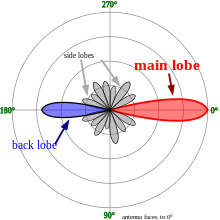
In electromagnetics, directivity is a parameter of an antenna or optical system which measures the degree to which the radiation emitted is concentrated in a single direction. It is the ratio of the radiation intensity in a given direction from the antenna to the radiation intensity averaged over all directions.[1] Therefore, the directivity of a hypothetical isotropic radiator, a source of electromagnetic waves which radiates the same power in all directions, is 1, or 0 dBi.
An antenna's directivity is greater than its gain by an efficiency factor, radiation efficiency.[1] Directivity is an important measure because many antennas and optical systems are designed to radiate electromagnetic waves in a single direction or over a narrow-angle. By the principle of reciprocity, the directivity of an antenna when receiving is equal to its directivity when transmitting.
The directivity of an actual antenna can vary from 1.76 dBi for a short dipole to as much as 50 dBi for a large dish antenna.[2]